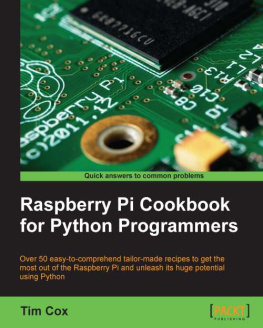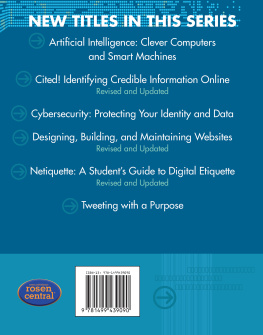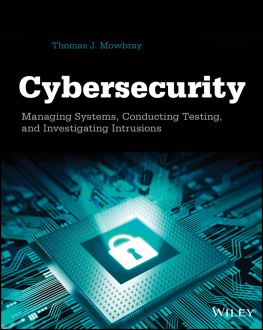Everyday
Cybersecurity
Everyday
Cybersecurity
A practical approach to understanding cybersecurity, security awareness, and protecting your personal information and identity.
Christopher K. Cox
Cover by Stephen C. Cox
Edited by Kaitlyn S. Hedges.
Copyright 2019 Christopher K. Cox. All rights reserved.
No part of this publication may be reproduced, distributed, or transmitted in any form or by any means, including photocopying, recording, or other electronic or mechanical methods, without the prior written permission of the publisher, except in the case of brief quotations embodied in reviews and certain other non-commercial uses permitted by copyright law.
eBook ISBN-13: 978-1-7330186-1-6
Dedication
First, and foremost, this book is dedicated to my wonderful wife, Esther. She has listened to me for years about my desire to write books. When the opportunity for this book came up, she was supportive and encouraging, even when the book consumed Saturdays, evenings, and some vacation time to complete. She is my biggest cheerleader.
This is also dedicated to my parents, who stoked my initial desires to write by reading my first books, way back in second grade. While I liked writing, they planted the seed of becoming a published author.
Acknowledgements
A big thanks goes to my brother, Steve, who created the cover for this book. When I talked to him about what I was looking for, he came up with this look, which is better than what I was thinking of.
I also want to acknowledge the hard work of my editor, Kaitlyn Hedges. She took my work and polished it up. Her eye for detail definitely caught things I had missed. I did add some things after she finished, so I may have introduced more errors.
Finally, I need to express my appreciation to the professors in my masters of cybersecurity program: Robert M. Jorgensen, Basil Hamdan, and C. Paul Morrey. They expanded on my previous experience and knowledge, and introduced me to new ones. Professor Jorgensen was particularly encouraging of this book.
Contents
Chapter 1:
Chapter 2:
Chapter 3:
Chapter 4:
Chapter 5:
Chapter 6:
Chapter 7:
Chapter 8:
Chapter 9:
Chapter 10:
Chapter 11:
Chapter 12:
Chapter 13:
Chapter 14:
Chapter 15:
Chapter 16:
Chapter 17:
Appendix A:
Appendix B:
Appendix C:
Authors Foreword
A couple of years after I started working as an IT technician, I began an undergraduate program in information systems. One of the classes I took was on information security. The topic intrigued me.
At the time, I was fairly new as the IT expert in my department. There were times during those first years when blank stares were returned as I tried to explain something, usually because Id use the technical terminology I was learning in classes. To me, I sounded like I knew what I was doing. Even in my writing, such as emails to staff, I often used the more technical terms. It took some time for me to realize I wasnt helping anyone with the techno-talk.
One of my directors told me, on more than one occasion, I needed to remember that most of the people I worked with were used to big buttons to push and levers to pull. It was his way of telling me to keep things simple and communicate at a level others understand.
Im not perfect at it, but Ive gotten better over 10+ years at learning to simplify techno-jargon.
One of my recurring thoughts over the years, especially during my masters program, has been how I can better help non-technical people be more security minded, without being too technical. Sometimes the technical terms are needed and need to be understood. However, too often people get lost in the alphabet-soup of acronyms and terminology.
When it comes to security, people are generally the weakest link, the most susceptible to failure, and the most likely to facilitate a data breach (often unintentionally). That is where the seeds to this book started.
My main intent with this book is to focus on the most important parts of cybersecurity, increase your awareness, and help you on your path to better security and data privacy. Its not an end-all discussion in cybersecurity, nor will it cover every aspect of cybersecurity.
As we go through the information, you may be surprised by the number of physical security practices discussed. Keep in mind, our real, physical lives are greatly affected by our virtual security, and physical security practices can also affect our cybersecurity.
Whenever possible, I have tried to use generic identifiers when referring to a person, such as a hacker. However, unless referring to a specific individual, I will sometimes use he or she interchangeably.
What you read and apply in your digital (and even physical) world can make your personal security stronger. To further strengthen your own and others cyber identity, I suggest taking what you learn and sharing it with othersfamily, friends, coworkers.
Helping others become more security conscious also helps protect your data, particularly if any of your family, friends, or coworkers have access to any part of your digital identity, including social media, email, and other web locations. Increasing their security awareness and practices strengthens the security chain that keeps your data safer.
If you do find this book helpful, please let others know by telling them about it and leaving a review.
Who Is This Book for?
This book is not a textbook or filled with techno-jargon. Tech terms will be used, but Ill try to explain them in simple, common language. My goal is to provide you with an essential, foundational understanding of cybersecurity.
This book is specifically for non-technical users who want to increase the security of their personal information. Its not necessarily a how-to book because computers, devices, and programs are constantly changing, and theres no way a single book could cover every cybersecurity scenario. Its more of the what and why behind cybersecurity, and having better security awareness.
However, this book can also be useful for technical users. Technical users who may find this book useful include those who:
Dont know much about cybersecurity and want to gain a better understanding of security issues.
Want to share an easy-to-understand cybersecurity awareness resource.
Need help speaking at a commonly understood level.
Most of the people I know are non-technical users. By this, I mean they use computers, but they arent IT people. Beyond installing a program by clicking Next, Next, and Finish and maybe customizing their computer with a background and some personalization, theyre unfamiliar with configuring systems and troubleshooting problems.
In over 11 years of technical support, Ive found most people would actually like to solve their own problems. Most want to be more cyber-aware and secure. Many think theyre dumb, but in my experience, we could all be considered dummies in something, but nobody wants to be dumb.
We need someone to talk in a language we understand and guide us through the process of understanding the unfamiliar. I can learn something from anyone, and Ill probably feel dumb when Im learning from someone elses expertise.
Ive seen eyes glaze over when an IT person speaks techno-talk to a non-technical user. Users would rather the IT expert take over in solving a computer problem because they believe most computer problems are too difficult to fix. And, most IT people just take over, because its easier and quicker for everyone.
Unfortunately, while it is easier for the tech to do this, it also perpetuates the idea that regular computer users arent able, or smart enough, to do things themselves.
Next page













